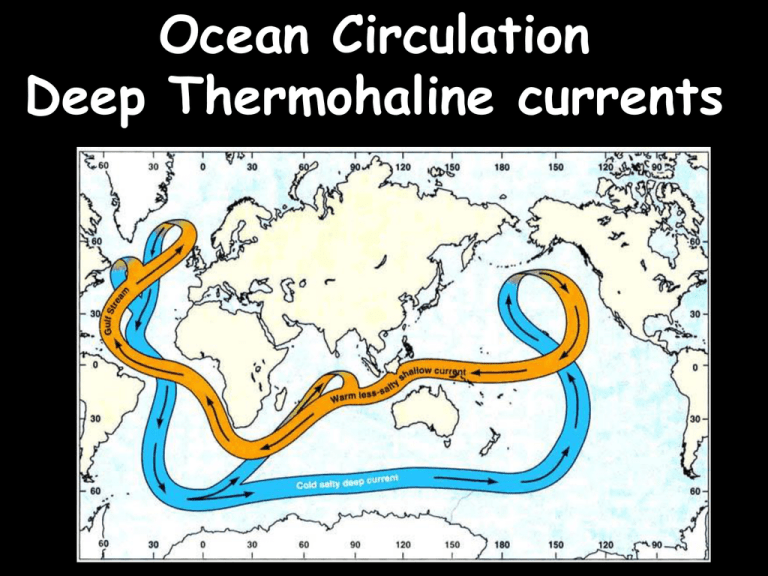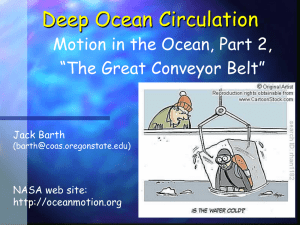Ocean Circulation Deep Thermohaline currents
advertisement

Ocean Circulation Deep Thermohaline currents Density = mass/volume (gr/cm3) D (ρ) ~(T, S) Density Layered Ocean! Surface layer – Ekman Spiral Pycnocline Layer – Geostrophic curr. Deep Ocean – Thermohaline curr. Ocean Circulation 1. Surface Circulation Wind Driven – – – – – Ekman Transport and Geostrophic Currents Surface layer and Picnocline zone 0 – 50,100m / 50,100m - ~1000m Affects ~25% of total water mass Fast (1-2 m/s) Surface Geostrophic and Deep Thermohaline Circulation Ocean Circulation 1. Surface Circulation Wind Driven – – – – – Ekman Transport and Geostrophic Currents Surface layer and Picnocline zone 0 – 50,100m / 50,100m - ~1000m Affects ~25% of total water mass Fast (1-2 m/s) 2. Deep Circulation Density Driven – – – – Thermohaline Circulation Below Picnocline zone (>~1000m) Affects ~75% of total water mass Slow (~ m/day) Deep Thermohaline Circulation • T, S are CONSERVATIVE properties – TS properties attained at the surface – Change only by mixing • (Non-Conservative Properties) – O2, Nutrients • Oceans are layered according to water densities!!! H20: Temperature and Density Seawater: Temperature and Density Seawater: Ice Formation Seasonal changes of surface layer thermocline •Surface seasonal thermocline •Deep permanent thermocline Latitudinal changes of surface layer salinity TS Plots Represent the influence of TS on density (iso-picnolines) TS Plot example Example: CTD Hydrographic Survey Example: CTD Casts Line ‘A’ T S D http://tabs.gerg.tamu.edu/gomoms/ctddata.html Example: TS Diagram for CTD Line A Deep Thermohaline Circulation • So… where do Deep Waters Form? – TS properties attained at the surface – TS properties remain remarkably constant – TS properties only altered by water mixing Deep Water Formation Major Water Masses – Thermohaline Circulation • • • • Central Waters (0-1000m) Intermediate Waters (1000-2000m) Deep Waters (2000-5000m) Bottom Waters (over ocean bottom) Atlantic Deep Waters • AABW • Antarctic Atlantic Bottom Water • -1.9 oC - 34.6 o/oo (cold & “fresh”) • Forms in the Weddell Sea, during southern winter ice formation • NADW • North Atlantic Deep Water • 4 oC - 34.9 o/oo (“warm” & saline) • Forms by cooling of saline Atlantic surface waters during northern winters, in the Norwegian and Greenland Seas Atlantic Deep Waters • AIW • Antarctic Intermediate Water • 2.2 oC - 33.8 o/oo (cold & “fresh”) • Forms in sub-polar regions, in the Antarctic Convergence zone • Extends Northward up to 25oN • (NAIW – North Atlantic Intermediate Water) • MIW • • • • Mediterranean Intermediate Water 11.9 oC - 35.5 o/oo (warm and very saline) Spills from Mediterrenan over the Gibraltar Sill Forms a tongue in the Atlantic ~1000m deep Atlantic Surface Waters • NACW • North Atlantic Central Water • 24 oC - 36 o/oo (very warm & very saline) • Surface waters, low density Atlantic Deep Water Masses Atlantic Deep Water Masses Weddell Sea – formation AABW Weddell Sea Mediterranean Intermidiate Water Tracing Deep water masses TS Diagrams Coriolis Effect on Thermohaline Circulation North Atlantic Deep Conveyer belt – 1000 year cycles Conveyor Belt “engine” North Atlantic Deep Conveyer belt – 1000 year cycles Pacific Ocean Thermohaline Circulation











